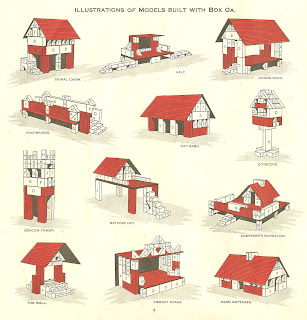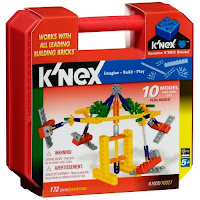
The Fourth Froebel Gift consists of eight oblong blocks which relate to the cubes of the
Third Froebel Gift by being half as thick, the same width, and twice as long.
That 1:2:4 ratio is exactly that of the Unit Block which have formed the basis of Unit Block (or "Kindergarten Block") sets since 1914.

So, while I often do ift #4 exercises with the specified size blocks of 12.5 mm x 25 mm x 50 mm, I am also inclined to grab other blocks of the same proportions, and most often, those are Unit Blocks.
Going the other direction, if you have some Unit Blocks, and are looking for some basic designs to build, the patterns that appeared in old guides to Froebel Kindergarten activities are a very good start.

You can build them strictly by the rules, with just the 1:2:4 unit blocks, of you can use a mixture of half-units and units, as I did in the photo at top, a choice which may be forced on you by the occasional tendency of modern Unit Block sets to be somewhat sparse on actual Unit Blocks.

I have included here all of the Gift #4 "Forms of Life" included in Edward Wiebe's
Paradise of Childhood, of 1869 (mine is a 1907 printing of the 1896 edition; recently
reprinted in paperback), where the author acknowledges that "the plates accompanying this work are reprints from 'Goldammer's Kindergarten,' a book recently [also in 1869!] published in Germany."
The plethora of designs for the various Froebel Gifts that were widely published in a variety of books (in many languages) may have been a key part of the downfall of Froebel's style of Kindergarten: the designs were taken by uninspired teachers as being prescriptive, ignoring Froebel's intent that the designs be mere examples, and that the children should construct "forms of life" that had meaning for them, in their own lives. [See
Inventing Kindergarten for more on Froebel and early Kindergartens.]

I think that in their reaction to that, the inventors of modern Kindergartens and modern Unit Blocks have tilted too far the other way, and ask us to do everything from scratch, rather than giving us some ideas and practice constructions to get us started.

With any design set, I suggest building some example designs to learn the syntax of constructing, then modifying the plans from ones own inspiration, and only then building entirely new creations. And even after exploring with full creative freedom, I believe returning to example designs, occasionally or frequently, can be an important process of the learning process.
Creative opportunities for modification or freestyle building can be enhanced by adding additional blocks, a few at a time, but I suggest starting with just enough to build the designs: 8 unit blocks, or if there is a shortage, as many unit blocks as are available, and two half-unit blocks in place of each missing unit block.

If more than eight unit blocks are available, then initial expansion of the play set might best be more basic units - in recent years, much has been made by having block sets consisting of blocks of all the same shape, such as
Kapla or
Dr. Drew's Discovery Blocks, and there is indeed some value in that, as Friederich Froebel discovered some time before 1836.
So click on each of the design sheets for a high resolution version, print them out, and enjoy some good block play.



















